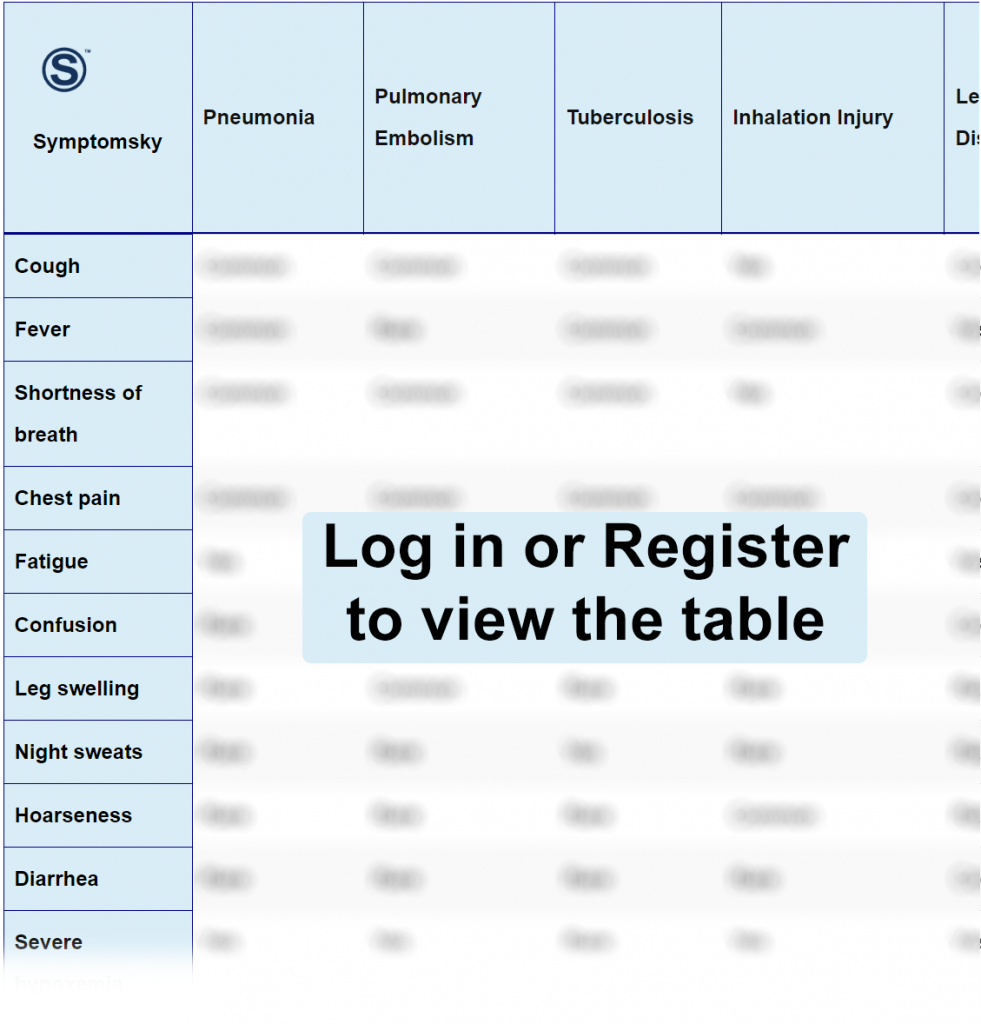Contents
- 1 Pneumonia Differential Diagnosis Table:
- 2 How To Distinguish Pneumonia from Other Diseases
- 2.1 Distinguish Pulmonary Embolism from Pneumonia – Diagnosis
- 2.2 Distinguish Tuberculosis from Pneumonia – Diagnosis
- 2.3 Distinguish Inhalation Injury from Pneumonia – Diagnosis
- 2.4 Distinguish Legionnaires’ Disease from Pneumonia – Diagnosis
- 2.5 Distinguish Acute Respiratory Distress Syndrome (ARDS) from Pneumonia – Diagnosis
- 2.6 Distinguish Interstitial Lung Disease (ILD) from Pneumonia – Diagnosis
- 2.7 Distinguish Lung Abscess from Pneumonia – Diagnosis
- 2.8 Distinguish Bronchiolitis from Pneumonia – Diagnosis
- 3 Important Red Flags with Pneumonia
Pneumonia Differential Diagnosis Table:

Lungs are not sterile; rather, they have their own microbiome. Any misbalance in this natural community of bacteria triggers a reaction resulting in infection. Pneumonia is a form of lower respiratory tract infection that affects the lungs parenchyma, specifically the alveolar space.
Pneumonia normally produces respiratory symptoms, accompanied by systemic ones. The common respiratory symptoms include cough with or without sputum production, blood in cough, dyspnea, and chest pain. The systemic symptoms include fever, fatigue, loss of appetite, and myalgia.
How To Distinguish Pneumonia from Other Diseases
Distinguish Pulmonary Embolism from Pneumonia – Diagnosis
Pulmonary embolism (PE) is caused by a blood clot that develops anywhere in the body, detaches, moves to the lungs, and blocks the blood flow.
- As the clot frequently originates in the deep leg veins, pulmonary embolism is commonly associated with deep venous thrombosis (DVT). As a result, these patients usually have symptoms that suggest the presence of deep venous thrombosis, such as leg pain, swelling, and discoloration. Since there is no link between pneumonia and DVT, these symptoms are not common in pneumonia.
- Moreover, pulmonary embolism has a sudden onset, and fever, if it arises, arises in the late stages. Pneumonia develops gradually, and fever, along with cough, is the first indication of the disease.
- Myalgia and arthralgia are also commonly present in pneumonia, along with fatigue and fever. Some people also complain of severe headaches. These symptoms are not common to pulmonary embolism.
Distinguish Tuberculosis from Pneumonia – Diagnosis
Tuberculosis is a chronic infection of the lungs caused by bacteria, specifically mycobacterium species. It usually affects the lungs, but it can also affect the gastrointestinal tract and lymphatic system.
- Tuberculosis is a chronic infectious disease; it develops slowly, stays for a long time, usually months or years. On the other hand, pneumonia is an acute infection that arises for a short period, lasting between days and weeks.
- Tuberculosis frequently causes severe weight loss among the affected individuals. Although pneumonia produces significant weakness, it is not actively involved in weight loss.
- Sweating during nighttime is excessively common among tuberculosis patients. This is a rare finding in pneumonia cases.
“A bacterial culture testing is the definitive diagnosis that distinguishes them.”
Distinguish Inhalation Injury from Pneumonia – Diagnosis
Inhalation injury refers to the consequential injury after inhaling something damaging like smoke, chemical vapors, toxins, or irritants.
- These individuals typically present with dizziness, confusion, or symptoms of syncope. Pneumonia is not associated with these symptoms.
- Hoarseness is uncommon in pneumonia, but it can be seen in people who have suffered inhalation injury.
- These people have difficulty in swallowing (odynophagia) due to the burning of the throat, which is never seen in pneumonia patients.
“Inhalation injury patients always give a history of traumatic exposure to flames or smoke.”
Distinguish Legionnaires’ Disease from Pneumonia – Diagnosis
Legionnaires’ Disease is a form of pneumonia, caused by Legionella bacteria, which is more severe.
- Patients suffering from Legionnaires’ disease are often found to be mentally confused. However, with pneumonia, it is only common among older individuals.
- The literature links Legionnaires’ disease to neurological manifestations like hallucinations, impaired cognition, and ataxia. This is uncommon among pneumonia patients.
- Relative bradycardia, which is a low pulse in spite of the presence of high body temperature, can be present in Legionnaires’ disease but never in pneumonia.
Distinguish Acute Respiratory Distress Syndrome (ARDS) from Pneumonia – Diagnosis
Acute respiratory distress syndrome (ARDS) is an acute inflammatory disease of the lungs that results in fluid accumulation in the alveoli and, ultimately, hypoxia in critically ill patients.
- Acute respiratory distress syndrome produces severe dyspnea that results in a significant reduction in blood oxygen levels. These patients frequently require mechanical ventilation for breathing. Pneumonia also produces dyspnea, but it is usually not as severe.
- In the case of cyanosis, this condition can turn the skin color blue; however, this can never be seen in pneumonia patients.
Distinguish Interstitial Lung Disease (ILD) from Pneumonia – Diagnosis
Interstitial Lung Disease (ILD) is a group of diseases, characterized by pulmonary fibrosis leading to difficulty breathing and hypoxia.
- Interstitial Lung Disease produces a dry cough with no mucus. Pneumonia predominantly produces phlegm with a cough.
- Moreover, it results in unexplained weight loss, which is uncommon in pneumonia.
- Pleuritic chest pain, a very common symptom of pneumonia, is not common in Interstitial Lung Disease (ILD).
Distinguish Lung Abscess from Pneumonia – Diagnosis
A lung abscess is an infection that results in liquefactive necrosis of the lung’s parenchyma.
- Lung abscess produces low-grade fever, while pneumonia produces high-grade fever.
- Lung abscesses frequently produce unexplained weight loss, which is a very rare finding in pneumonia.
- Moreover, some cases of lung abscess produce night sweats, rare to be found in pneumonia.
Distinguish Bronchiolitis from Pneumonia – Diagnosis
Bronchiolitis is the viral infection of the lung’s bronchioles. It is rare in adults, but it can be present.
- Firstly, fever is not always present in bronchiolitis, and when it is, it is usually of low grade. With pneumonia, fever is generally high-grade and severe.
- Pneumonia actively causes chest pain, which is a rare finding in bronchiolitis.
- Bronchiolitis also causes a sore throat, while it is not seen in pneumonia.
Important Red Flags with Pneumonia
The symptoms of pneumonia are pretty common and can be confused with a cold and flu. Although pneumonia is treatable and not life-threatening, but in rare cases, it can lead to serious complications, especially in older and immunocompromised patients. Respiratory failure, acute respiratory distress syndrome, sepsis, septic shock, abscess, and pleural effusion are all examples of pneumonia complications. To detect it timely, common cold accompanied by chills, fever, and fatigue should always be investigated as soon as possible.
